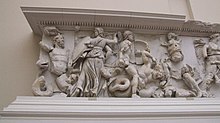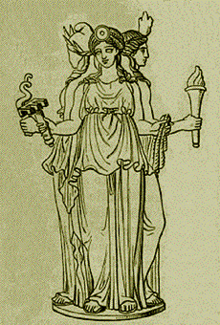Hecate

Hecate ( Greek Ἑκάτη ) is in Greek mythology the goddess of magic , theurgy , and necromancy (necromancy). She is the goddess of crossroads, thresholds and crossings, the guardian of the gates between the worlds.
history
The goddess is from a cult in Asia Minor in the 8th or 7th century BC. In the Greek religion, possibly from Caria . Evidence for this can be found in theophoric Carian personal names in Hekat- . In Anatolia, the goddess seems to have lacked the association with necromancy or witchcraft, where she was more likely a magna-mater figure.
In ancient Greece, Hecate became the goddess of witchcraft , magic and theurgy. Her cult was cultivated in secret: As the ruler of magic she was able to open access to the underworld, enable contact with spirits and the dead, as an oracle deity, reveal the future, and grant her followers power and wealth.
As a foreign goddess, Hecate did not find a permanent place in the Greek pantheon, her role was in conflict with already existing Greek deities, especially Artemis . She became an elusive goddess of the domestic sphere and transitions.
Pictorial representation
The oldest depictions of the goddess in Asia Minor show her enthroned and surrounded by lionesses. The oldest Greek representation also shows her enthroned, but otherwise without any attributes. Then she is shown young and carrying a torch. From the 4th century BC The triad becomes characteristic for her: three young beautiful women who either stand back to back or around a polo shirt. The oldest of these representations hold fruits, torches and an amphora in their hands. Later snakes, daggers, ropes, whips, bowls and keys are added. The triad of Hecate is particularly characteristic in Greece, while the single representation of the goddess predominates in Asia Minor.
Symbols

The oldest Greek image products such as vases or the Pergamon Altar , the torch her attribute or its symbol. Other symbols: dagger , snakes, key, cord, whip, bowl.
Animals of the underworld and the night were also associated with it, for example dogs , lizards , toads , polecats , owls and others.
myth
One of the basic sources for understanding the meaning of the mythical figure in antiquity is Hesiod's theogony. Hesiod describes Hecate as the daughter of the Titanide Asteria , which, as a floating island (Delos), made possible the birth of the twins Artemis and Apollo , and the Titan Perses , the god of destruction. In Hesiod's theogony , Hecate is the only one among the Titans who retains her independence and her original domains under the rule of Zeus .
Hesiod describes her as a very helpful goddess to people, she gives the shepherds fertile flocks, the fishermen full nets, the hunters rich booty, the athletes and warriors success and luck in battle. Besides Zeus, she is the only deity who can fulfill or deny every wish. But just as the goddess can give the blessing, she can take it again if she feels it is right. In addition, Hesiod describes the goddess Hecate as the nurse of all creatures. It seems to be strongly connected to people; in Hesiod's theogony it is the deity most frequently mentioned in connection with humans.
| Original text in German translation based on Lautwein |
|---|
|
But Phoibe made love to Koios. - (translated original text) |
Hecate also appears in the Homeric Demeter myth . She helps Demeter find her daughter Persephone , and after Persephone is reunited with Demeter, Hecate becomes Persephone's guide and companion. In the Gigantomachy , the attack of the giants against the Olympic gods , she fights on the side of the Olympians and burns the giant Klytios with her torches, whom Heracles then kills.
Hecate in Greek Philosophy
Hecate was especially venerated by the Neo-Platonists . They saw in it the world soul from which all souls spring and to which they return. They also saw in her a mediator between the world of men and the higher gods.
So z. B. the Neo-Platonist Proclus one of his hymns to them. The Middle Platonist Lucius Apuleius mentioned Hecate in his tradition of the fairy tale Amor und Psyche probably also in this role.
cult
The representation of the goddess went through several changes in the Greco-Roman area over time. From an original pre-Greek mother goddess (great mother) to a youthful goddess and guardian of thresholds and transitions, to a dark figure, around which many ideas entwine, and finally in late antiquity to a kind of universal goddess and world soul, which in itself the different Goddesses united.
Similar to Artemis , Hecate was viewed as the goddess of women and equated with her; similar to Artemis, she is called a goddess of obstetrics. Other fusions are known with Persephone . She also appeared under the name Baubo and was equated with Selene .
Hecate represents the aspect of transitions (birth, crossroads in particular of three paths) and transformation (magic and magic ) and was later worshiped as the goddess of witches . The public cult around Hecate was not very widespread in Greece, but it played an important role in the private and mystery cults. Offerings consisted of food, lambs, or dogs. One of their priestesses was Medea .
Hecate was greatly venerated by the common people. Their rituals were mainly held in private and under cover of darkness. She was asked to fulfill wishes for personal well-being (especially protection, guidance, happiness, prosperity). Offerings were made to her at crossroads, cemeteries and doorways (doorsteps).
The last day of the month, which fell on the new moon in the Athenian calendar , was sacred to the dead. On this day, Hecate, guardian of the underworld, was offered food offerings at crossroads. These foods were taboo. Touching them or eating from them was considered particularly reprehensible. Even so, it seems to have been common for poor people and homeless people to eat from them. There is also evidence that Hecate was worshiped on the full moon of Munychion (April / May).
In Lagina she had a temple and was also the main goddess of the city, otherwise she was worshiped at the entrances to temples of other goddesses, especially Artemis, Demeter, Persephone and Selene. In later times their cult became a mystery cult.
Nickname


Her nicknames were among others:
- Atropaia (keeping away evil)
- Chthonia (from the earth)
- Enodia (those on the way)
- Kleidukos (key bearer)
- Kourotrophos (nurse)
- Melana (the black one)
- Ourania (Heavenly)
- Perseis (light)
- Phosphoros (Light Bringer)
- Propolos (guide)
- Propylaia (goalkeeper)
- Skotia (those of the dark place)
- Soteira (Redeemer, Healer)
- Triformis
- Trioditis or trivia (three-way)
Modern
Hecate is interpreted as a pre-patriarchal goddess by supporters of matriarchal theories. Thomas Lautwein (2009) sees her as an “earth and sun goddess”. According to this, Hecate is the embodiment of the hidden, dark, mysterious aspect of a pre-patriarchal earth goddess. Lautwein relates this aspect to the dark aspect of the sun, which, according to ancient belief, wandered underground through the underworld from west to east at night. Only later was this hidden, dark, mysterious aspect of the sun assigned to the moon.
In today's paganism ( neopaganism ), Hecate is considered the guardian of magical knowledge. She is often invoked in the original form described by Hesiod as the omnipotent helpful goddess. Her independence and her triad as a virgin, mature independent woman and old sage form the complement and the opposite of the mother aspect of the Great Goddess . Her active power as the sun goddess and her materialism as the earth goddess are the complement and the opposite of the passive and ideal aspect of moon goddesses.
Trivia
In her novel Seelenfeuer, Barbara Wood describes a brew made from willow bark as the "Potion of Hecate". But there is no ancient source for this name. This remedy owes its actual pain-relieving effect to the salicylic acid contained in the willow bark , which is also the basis for ASA .
Hecate plays an important role in the video game Assassin's Creed Odyssey and is represented there as Isu (an ancient race that created mankind).
literature
- Sarah Iles Johnston: Hecate Soteira. A Study of Hekate's Roles in the Chaldean Oracles and Related Literature . Scholars Press, Atlanta (Georgia) 1990, ISBN 1-55540-426-X .
- Thomas Lautwein : Hecate, the dark goddess. History and present. Edition Roter Drache, Rudolstadt 2009, ISBN 978-3-939459-21-7 .
- Jane Davidson Reid: The Oxford Guide to Classical Mythology in the Arts, 1300-1990s. Volume 1, Oxford University Press, New York / Oxford 1993, ISBN 0-19-504998-5 , pp. 492f. (Compilation of the reception in modern literature and fine arts)
- Wilhelm Heinrich Roscher: Hecate 1 . In: Wilhelm Heinrich Roscher (Hrsg.): Detailed lexicon of Greek and Roman mythology . Volume 1,2, Leipzig 1890, Sp. 1885-1910 ( digitized version ). (outdated research status)
- Robert von Rudloff: Hecate in Ancient Greek Religion . Horned Owl Publishing, Victoria (BC) 1999, ISBN 0-9696066-8-0 .
- Haiganuch Sarian, Zlatozara Gočeva: Hecate . In: Lexicon Iconographicum Mythologiae Classicae . (LIMC), Volume 6.1, Artemis, Zurich 1992, ISBN 3-7608-8751-1 , pp. 985-1019 (text) and Volume 6.2, pp. 654-673 (illustrations); Supplements by Erika Simon in the supplementary section Supplementum 2009 : Supplement volume 1, Artemis, Düsseldorf 2009, ISBN 978-3-538-03520-1 , p. 238.
- Nina Werth: Hekate. Investigations on the three-figure goddess (= Antiquitates. Volume 37). Kovač, Hamburg 2006, ISBN 3-8300-2452-5 (also dissertation, Saarbrücken University 2006).
Web links
Individual evidence
- ↑ a b c d e f g h i j k l m n o p q r Thomas Lautwein : Hekate, the dark goddess. History and present. Edition Roter Drache, Rudolstadt 2009, ISBN 978-3-939459-21-7 .
- ↑ William Berg: Hecate: Greek or "Anatolian"? Numen 21.2 (August 1974, pp. 128-140), here p. 129: “ Since children are not called after spooks, it is safe to assume that Carian theophoric names involving hekat- refer to a major deity free from the dark and unsavory ties to the underworld and to witchcraft associated with the Hecate of Classical Athens. ”
- ^ William Arthur Heidel: The Day of Yahweh: A Study of Sacred Days and Ritual Forms in the Ancient Near East , American Historical Association, 1929, p. 514.
- ^ Simon Spawforth: The Oxford Classical Dictionary. Oxford University Press, 1996, p. 671: “ She is more at home on the fringes than in the center of Greek polytheism. Intrinsically ambivalent and polymorphous, she straddles conventional boundaries and eludes definition. ”
- ↑ Thomas Lautwein: Hecate, the dark goddess. History and present. Edition Roter Drache, Rudolstadt, 2009, ISBN 978-3-939459-21-7 , pp. 66-67.
- ↑ Barbara Wood: Soul Fire. 1st edition, Fischer Taschenbuch Verlag, Frankfurt am Main, 1989, ISBN 3-596-28367-1 .

